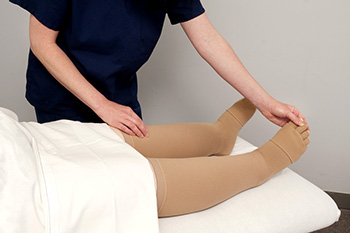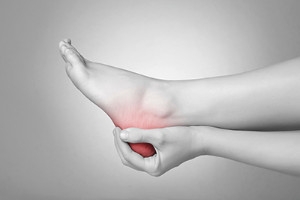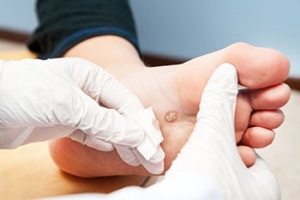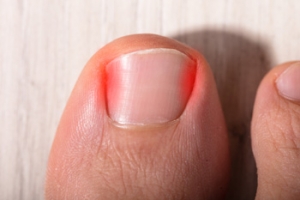
Lower Limb Swelling and Lupus
If you have lupus, which is a type of autoimmune disorder, you may notice swelling in your feet and ankles. Lower limb swelling occurs in approximately half of all people with lupus. Lupus frequently damages the kidneys, which are responsible for maintaining the correct quantities of fluid in the body. When the kidneys don’t work properly, fluid can build up in the lower limbs and lead to painful swelling. A podiatrist can help you reduce swelling in your feet and ankles. This foot specialist may suggest wearing compression stockings and changing your footwear, as well as improving your exercise habits or diet. They can also prescribe orthotics to increase your comfort and make it easier to walk. To learn more about caring for your feet when you have lupus, schedule an appointment with a podiatrist near you.
When dealing with systemic disease of the feet, it is extremely important to check the affected areas routinely so that any additional problems are caught quickly. If you have any concerns about your feet and ankles contact Dr. Anna Petrov from Family Foot & Ankle Care. Our doctor will assist you with all of your podiatric needs.
Systemic Diseases of the Feet
Systemic diseases affect the whole body, and symptoms usually are displayed in the feet. This condition can make a patient’s ability to walk unbearable. Systemic diseases include gout, diabetes mellitus, neurological disorders, and arthritis.
Gout – is caused by an excess of uric acid in the body. Common symptoms include pain, inflammation, and redness at the metatarsal/phalangeal joint of the base big toe. Gout can be treated by NSAIDs to relieve pain and inflammation, and other drugs that lower the acid levels in the body.
Diabetes mellitus – is an increase in the level of blood sugar that the body cannot counteract with its own insulin. Failure to produce enough insulin is a factor in Diabetes.
Diabetes of the Feet
Diabetic Neuropathy – may lead to damaged nerves and affect the feet through numbness and loss of sensation.
Peripheral Vascular Disease – can restrict the blood flow to the feet, and often times lead to amputation of the feet.
If you have any questions please feel free to contact one of our offices located in Wheeling and Chicago, IL . We offer the newest diagnostic and treatment technologies for all your foot and ankle needs.
Systemic Diseases of the Foot
There are several systemic diseases, or diseases that affect the whole body, that either display symptoms in the feet or affect the health of the feet. Common systemic diseases that affect the overall health of the feet, and the patient’s ability to walk comfortably, include gout, diabetes mellitus, neurological disorders, and arthritis, among others.
In gout, which is caused by an excessive buildup of uric acid in the body, the most common symptoms of pain, inflammation, and redness occur at the metatarsal/phalangeal joint at the base of the big toe. Any excess levels of uric acid crystallize and are deposited in tendons, joints, and surrounding bone and muscle tissue. Gout is commonly treated with NSAIDs to relieve pain and inflammation and other drugs to lower uric acid levels in the body. Gout most commonly affects those who are overweight, have low protein diets and lead a more sedentary lifestyle.
Diabetes mellitus is an increase in the level of blood sugar in which the body cannot counteract with naturally occurring insulin in the body. The three types of diabetes, Type I, Type II and Gestational Diabetes, are all signs the body is either not producing enough insulin or is not efficiently using the insulin that is produced. Gestational diabetes only affects women who are pregnant and have never, prior to pregnancy, exhibited symptoms of the disease.
There are two main issues that affect the feet that are commonly caused by diabetes. They include diabetic neuropathy and peripheral vascular disease. Diabetic neuropathy can lead to damaged nerves and affect the feet through numbness and loss of sensation. Peripheral vascular disease restricts the flow of blood to the foot and can, in extreme cases, lead to the necessity of amputating the foot. Peripheral issues that are caused by diabetes and can affect the foot include athlete’s foot, nail infections, corns, blisters, bunions, severe dry skin, plantar warts and ingrown toenails. These can all be attributed to the decrease of blood flow to the foot.
Neurological disorders and rheumatoid arthritis can also have severe impact on the health of the feet. Neurological disorders can affect the nerves in the main structure of the foot and cause loss of sensation and possible decreased muscle response. Rheumatoid arthritis can affect the bones and joint structures of the foot, making it impossible to walk normally without serious pain.
All systemic diseases that affect the foot can effectively be treated to minimize joint and muscle damage if they are diagnosed early and treated with medication and lifestyle therapy. Diabetes patients must monitor their blood sugar levels and work with their physician to keep their levels as close to normal as possible. Rheumatoid arthritis patients should work with their physician to ensure the proper medications are being taken to reduce the amount of damage to the joints of the body.
Sever’s Disease 101
 Sever’s disease is an injury that causes pain in the back of the heel in patients between the ages of 8 and 15. this condition may be a result of a growth spurt when the muscles and tendons in the calves can not keep up with the growth rate of the bones. The tight muscles put more stress on the Achilles tendon particularly where it attaches to the heel bone. Sever’s disease is most common in active adolescents who do a lot of sports training or physical activity. The most common sign is pain in the back of the heel, but other signs of Sever’s disease include worsening pain with physical activity and pain that gets worse throughout the day. If your child is complaining about pain in their heels, consulting with a podiatrist for a proper diagnosis and treatment is suggested.
Sever’s disease is an injury that causes pain in the back of the heel in patients between the ages of 8 and 15. this condition may be a result of a growth spurt when the muscles and tendons in the calves can not keep up with the growth rate of the bones. The tight muscles put more stress on the Achilles tendon particularly where it attaches to the heel bone. Sever’s disease is most common in active adolescents who do a lot of sports training or physical activity. The most common sign is pain in the back of the heel, but other signs of Sever’s disease include worsening pain with physical activity and pain that gets worse throughout the day. If your child is complaining about pain in their heels, consulting with a podiatrist for a proper diagnosis and treatment is suggested.
Sever's disease often occurs in children and teens. If your child is experiencing foot or ankle pain, see Dr. Anna Petrov from Family Foot & Ankle Care. Our doctor can treat your child’s foot and ankle needs.
Sever’s Disease
Sever’s disease is also known as calcaneal apophysitis, which is a medical condition that causes heel pain I none or both feet. The disease is known to affect children between the ages of 8 and 14.
Sever’s disease occurs when part of the child’s heel known as the growth plate (calcaneal epiphysis) is attached to the Achilles tendon. This area can suffer injury when the muscles and tendons of the growing foot do not keep pace with bone growth. Therefore, the constant pain which one experiences at the back of the heel will make the child unable to put any weight on the heel. The child is then forced to walk on their toes.
Symptoms
Acute pain – Pain associated with Sever’s disease is usually felt in the heel when the child engages in physical activity such as walking, jumping and or running.
Highly active – Children who are very active are among the most susceptible in experiencing Sever’s disease, because of the stress and tension placed on their feet.
If you have any questions, please feel free to contact one of our offices located in Wheeling and Chicago, IL . We offer the newest diagnostic and treatment technologies for all your foot and ankle injuries.
Sever's Disease
Sever’s disease, also known as calcaneal apophysitis is a common bone disorder that occurs during childhood. The disease is defined as an inflammation of the growth plate in the heel. When a child has a growth spurt, his heel bone grows faster than the muscles, tendons, and ligaments in his leg. This disease is a result of overuse. The people who are most likely to be affected by this disease are children who are in a growth spurt, especially boys who are from the ages of 5 to 13 years old. 60% of children with Sever’s disease have both heels involved.
Symptoms of this disease are heel pain that intensifies during running and jumping activities. The pain is typically localized to the posterior part of the heel. Symptoms may be severe, and they can easily interfere with daily activities. Children who play soccer, baseball, and basketball are more likely to develop Sever’s disease.
Your doctor will diagnose your child based on his or her symptoms, x-rays are generally not helpful in diagnosing this disease. Your doctor may examine both heels and ask your child questions about his or her activity level in sports. Your doctor may then use the squeeze test on your child’s heel to see if there is any pain. Nevertheless, some doctors might still use x-rays to rule out any other issues such as fractures, infections, and tumors.
Sever’s disease can be prevented by maintaining good flexibility while your child is growing. Another prevention method is to wear good-quality shoes that have firm support and a shock-absorbent sole. Sever’s disease can be treated by ceasing any activity that causes heel pain. You should apply ice to the injured heel for 20 minutes 3 times a day. Additionally, orthotics should be used for children who have high arches, flat feet, or bowed legs.
If you suspect your child has Sever’s disease, you should make an appointment with your podiatrist to have his or her foot examined. Your doctor may recommend nonsteroidal anti-inflammatory drugs (NSAIDs), such as ibuprofen or naproxen to relieve pain. In more severe cases, your child may need a cast to rest his or her heel. Fortunately, Sever’s disease does not cause long-term foot problems. After treatment, your child should start to feel better within two weeks to two months.
What Is a Plantar Wart?
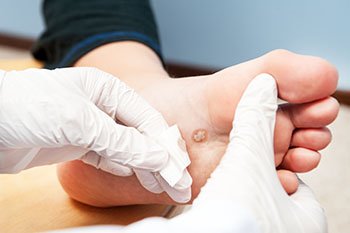 Common warts that form on the bottom of the foot are known as plantar warts. Plantar warts form as a result of the human papilloma virus, (also known as HPV) which tends to thrive in warm and moist environments like locker rooms, shower floors, and swimming pools. Common signs that the skin growth on the foot is a plantar wart include the growth being raised, feeling hard, having a rough surface, or possibly having small black dots near the center. Plantar warts may also be painful when standing or applying pressure to the wart. While many warts eventually go away on their own, plantar warts that persist should be looked at by a podiatrist. Patients with diabetes, circulatory problems, or vascular disease should also have their plantar wart checked by a podiatrist.
Common warts that form on the bottom of the foot are known as plantar warts. Plantar warts form as a result of the human papilloma virus, (also known as HPV) which tends to thrive in warm and moist environments like locker rooms, shower floors, and swimming pools. Common signs that the skin growth on the foot is a plantar wart include the growth being raised, feeling hard, having a rough surface, or possibly having small black dots near the center. Plantar warts may also be painful when standing or applying pressure to the wart. While many warts eventually go away on their own, plantar warts that persist should be looked at by a podiatrist. Patients with diabetes, circulatory problems, or vascular disease should also have their plantar wart checked by a podiatrist.
Plantar warts can be very uncomfortable. If you need your feet checked, contact Dr. Anna Petrov from Family Foot & Ankle Care. Our doctor will assist you with all of your foot and ankle needs.
About Plantar Warts
Plantar warts are the result of HPV, or human papillomavirus, getting into open wounds on the feet. They are mostly found on the heels or balls of the feet.
While plantar warts are generally harmless, those experiencing excessive pain or those suffering from diabetes or a compromised immune system require immediate medical care. Plantar warts are easily diagnosed, usually through scraping off a bit of rough skin or by getting a biopsy.
Symptoms
- Lesions on the bottom of your feet, usually rough and grainy
- Hard or thick callused spots
- Wart seeds, which are small clotted blood vessels that look like little black spots
- Pain, discomfort, or tenderness of your feet when walking or standing
Treatment
- Freezing
- Electric tool removal
- Laser Treatment
- Topical Creams (prescription only)
- Over-the-counter medications
To help prevent developing plantar warts, avoid walking barefoot over abrasive surfaces that can cause cuts or wounds for HPV to get into. Avoiding direct contact with other warts, as well as not picking or rubbing existing warts, can help prevent the further spread of plantar warts. However, if you think you have developed plantar warts, speak to your podiatrist. He or she can diagnose the warts on your feet and recommend the appropriate treatment options.
If you have any questions please feel free to contact one of our offices located in Wheeling and Chicago, IL . We offer the newest diagnostic and treatment technologies for all your foot and ankle needs.
Plantar Warts
Plantar warts are growths that typically appear on the heels or other weight-bearing areas of the feet. These warts are caused by the human papillomavirus (HPV). The virus enters the body through breaks in the skin, such as cuts, that are on the bottom of the feet. Plantar warts are more likely to affect children and teenagers, people with weakened immune systems, people who have a history with plantar warts, and people who walk barefoot in environments exposed to a wart-causing virus.
If you suspect you have plantar warts, you may have the following symptoms: pain or tenderness while walking, a lesion that interrupts the ridges in the skin of your foot, small fleshy lesions on the bottom of the foot, or a callus where a wart has grown inward over a well-defined spot on the skin.
HPV causes plantar warts to form and is very common. There are more than 100 kinds of the virus in existence. However, only a few of them cause warts on the feet. The other types of HPV are likely to cause warts on other parts of the body.
If you have plantar warts, your podiatrist may try different treatment methods depending on your specific case. Some treatments for plantar warts are peeling medicines (salicylic acid), freezing medicines (cryotherapy), or surgical procedures. Laser treatments and vaccines are also used to treat plantar warts.
How Long Does an Ankle Sprain Take To Heal?
 Ankle sprains occur when one or more ligaments in the ankle overstretch or tear. This usually occurs due to a sudden twisting of the ankle, or from falls or direct impacts. How long it takes to recover from an ankle sprain depends on the severity of the sprain. A Grade 1 sprain is considered mild and is characterized by minimal pain and swelling. It typically takes a few days for the injury to heal. However, while a Grade 1 sprain is healing, the ankle is in a weakened, unstable state and can be prone to re-injury. A Grade 2 sprain is moderate and is characterized by swelling, bruising, and difficulty walking. This type of sprain takes several days to weeks to heal. A Grade 3 sprain, the most severe type, is characterized by swelling, bruising, ankle instability, and an inability to bear weight on the ankle. Recovering from a Grade 3 sprain takes between 6 and 8 weeks. If you have sprained your ankle, please seek the care of a podiatrist.
Ankle sprains occur when one or more ligaments in the ankle overstretch or tear. This usually occurs due to a sudden twisting of the ankle, or from falls or direct impacts. How long it takes to recover from an ankle sprain depends on the severity of the sprain. A Grade 1 sprain is considered mild and is characterized by minimal pain and swelling. It typically takes a few days for the injury to heal. However, while a Grade 1 sprain is healing, the ankle is in a weakened, unstable state and can be prone to re-injury. A Grade 2 sprain is moderate and is characterized by swelling, bruising, and difficulty walking. This type of sprain takes several days to weeks to heal. A Grade 3 sprain, the most severe type, is characterized by swelling, bruising, ankle instability, and an inability to bear weight on the ankle. Recovering from a Grade 3 sprain takes between 6 and 8 weeks. If you have sprained your ankle, please seek the care of a podiatrist.
Ankle sprains are common but need immediate attention. If you need your feet checked, contact Dr. Anna Petrov from Family Foot & Ankle Care. Our doctor can provide the care you need to keep you pain-free and on your feet.
How Does an Ankle Sprain Occur?
Ankle sprains take place when the ligaments in your ankle are torn or stretched beyond their limits. There are multiple ways that the ankle can become injured, including twisting or rolling over onto your ankle, putting undue stress on it, or causing trauma to the ankle itself.
What Are the Symptoms?
- Mild to moderate bruising
- Limited mobility
- Swelling
- Discoloration of the skin (depending on severity)
Preventing a Sprain
- Wearing appropriate shoes for the occasion
- Stretching before exercises and sports
- Knowing your limits
Treatment of a Sprain
Treatment of a sprain depends on the severity. Many times, people are told to rest and remain off their feet completely, while others are given an air cast. If the sprain is very severe, surgery may be required.
If you have suffered an ankle sprain previously, you may want to consider additional support such as a brace and regular exercises to strengthen the ankle.
If you have any questions please feel free to contact one of our offices located in Wheeling and Chicago, IL . We offer the newest diagnostic and treatment technologies for all your foot and ankle needs.
Ankle Sprains
Ankle sprains occur when ligaments that support the ankle stretch beyond their limits and tear. These types of injuries are very common and can occur in people of all ages. Sprains may range from mild to severe, depending on how much damage is done to the ligaments. If a sprain goes untreated, a more severe sprain may occur which can further damage the ankle. Repeated ankle sprains can lead to chronic ankle pain.
There are some risk factors that can increase your risk of suffering a sprained ankle. Those who participate in sports, walk on uneven surfaces, have a prior ankle injury, are in poor physical condition, or wear improper shoes are more likely to get a sprained ankle.
There are a few symptoms to look out for if you suspect you are suffering from a sprained ankle. Some common symptoms are swelling, bruising, tenderness, and instability of the ankle. In cases where the tearing of the ligaments is severe, there may be a “popping” sound when the strain occurs.
The RICE method is proven to be effective in treating ankle sprains. RICE stands for Rest, Ice, Compression, and Elevation. Rest is important for treatment, especially within the first 24 to 48 hours. You should also ice your sprained ankle for the first 48 hours for 20 minutes at a time. A small piece of cloth should be placed between the ice and the affected area. For the compression step, you should wear a brace that is snug, but not too tight that it cuts off circulation. When choosing a brace, be sure to choose one that is suitable for the type of ankle sprain you have. Lastly, you should elevate your foot above the heart as often as possible.
After you treat a sprain, you should go through rehabilitation to prevent the injury from occurring again. There are three phases to the rehab process. The first phase involves resting, protecting, and reducing the swelling of the injury. The second phase consists of restoring the ankle’s flexibility, range of motion, and strength. The third phase consists of slowly returning to activity and maintenance exercises.
If you suspect you have an ankle sprain, you shouldn’t hesitate to consult with your podiatrist. Your podiatrist will be able to give you a proper diagnosis and a suitable treatment option for your condition.
Two Ways an Ingrown Toenail Can Develop
 The two ways an ingrown toenail can develop consists of the nail growing into the skin or it can grow over the nail. A common reason for this condition to occur includes improper trimming of the toenails. They may curl and dig under the skin, possibly causing the nail and surrounding area to become red and swollen. In severe cases the affected nail may become infected and pus could ooze out. Additionally, some patients wear shoes that do not have adequate room for the toes to move freely in and this may cause the toenails to become ingrown. Relief may be found when the nail is soaked in warm water and this can make it easier to pull the nail away from the skin using a piece of cotton. It is strongly suggested that you seek the counsel of a podiatrist who can properly manage this condition if you have an ingrown toenail or recurring ingrown toenails.
The two ways an ingrown toenail can develop consists of the nail growing into the skin or it can grow over the nail. A common reason for this condition to occur includes improper trimming of the toenails. They may curl and dig under the skin, possibly causing the nail and surrounding area to become red and swollen. In severe cases the affected nail may become infected and pus could ooze out. Additionally, some patients wear shoes that do not have adequate room for the toes to move freely in and this may cause the toenails to become ingrown. Relief may be found when the nail is soaked in warm water and this can make it easier to pull the nail away from the skin using a piece of cotton. It is strongly suggested that you seek the counsel of a podiatrist who can properly manage this condition if you have an ingrown toenail or recurring ingrown toenails.
Ingrown toenails may initially present themselves as a minor discomfort, but they may progress into an infection in the skin without proper treatment. For more information about ingrown toenails, contact Dr. Anna Petrov of Family Foot & Ankle Care. Our doctor can provide the care you need to keep you pain-free and on your feet.
Ingrown Toenails
Ingrown toenails are caused when the corner or side of a toenail grows into the soft flesh surrounding it. They often result in redness, swelling, pain, and in some cases, infection. This condition typically affects the big toe and may recur if it is not treated properly.
Causes
- Improper toenail trimming
- Genetics
- Improper shoe fitting
- Injury from pedicures or nail picking
- Abnormal gait
- Poor hygiene
You are more likely to develop an ingrown toenail if you are obese, have diabetes, arthritis, or have any fungal infection in your nails. Additionally, people who have foot or toe deformities are at a higher risk of developing an ingrown toenail.
Symptoms
Some symptoms of ingrown toenails are redness, swelling, and pain. In rare cases, there may be a yellowish drainage coming from the nail.
Treatment
Ignoring an ingrown toenail can have serious complications. Infections of the nail border can progress to a deeper soft-tissue infection, which can then turn into a bone infection. You should always speak with your podiatrist if you suspect you have an ingrown toenail, especially if you have diabetes or poor circulation.
If you have any questions, please feel free to contact one of our offices located in Wheeling and Chicago, IL . We offer the newest diagnostic and treatment technologies for all your foot care needs.




